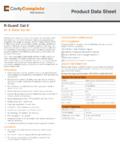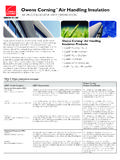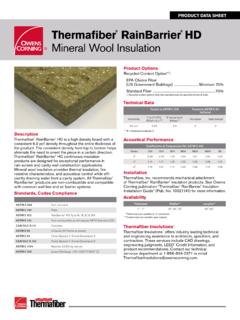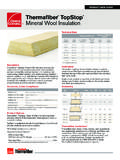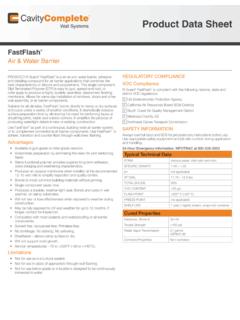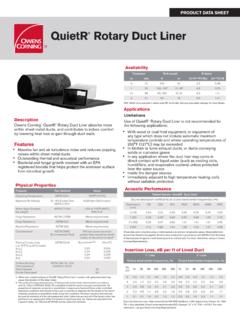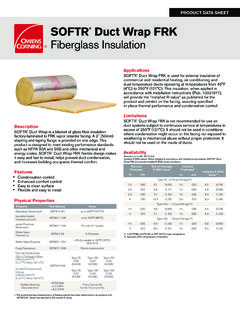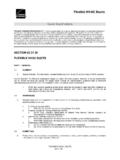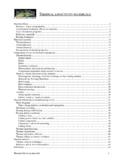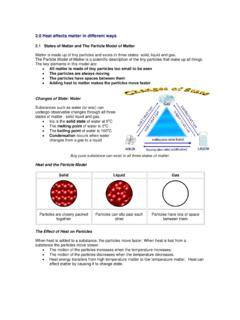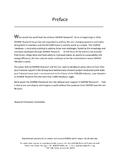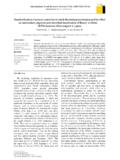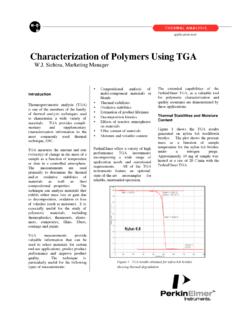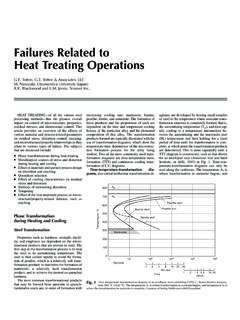Transcription of Capturing the Thermal Performance of …
1 Technical BulletinCapturing the Thermal Performance ofFOAMULAR Extruded Polystyrene (XPS) vs. Polyisocyanurate Exploring the impact of temperature dependent R-values on rigid insulation and building performanceSummaryExtruded polystyrene (XPS) and Polyisocyanurate (polyiso) rigid foam insulation are both designed to provide Thermal resistance in residential and commercial building construction applications. For example, in exterior above-grade wall assemblies, a layer of rigid insulation is often specified to comply with the prescriptive R-value requirements outlined in energy codes and standards such as the International Energy Conservation Code (IECC) and American Society of heating, Refrigeraton and Air-conditioning Engineer s (ASHR AE) However, despite being used in similar applications, XPS and polyiso have very distinct product compositions that can result in significant Thermal Performance technical bulletin describes how the R-value of rigid insulation changes based on the temperature it is exposed to.
2 In other words, it is temperature dependent. For example, the R-value of XPS improves as the temperature declines. However, the R-value of polyiso can decrease substantially as the temperature declines. New research also illustrates that wall assemblies built with XPS can provide greater Thermal Performance than those that are built with polyiso. This is especially true in colder the significant impact that continuous insulation has on the Thermal and moisture Performance of a building envelope, the differences in R-value Performance between XPS and polyiso deserve careful consideration when selecting a rigid Published R-valuesTo help consumers understand and compare the Thermal Performance of insulation products, the Federal Trade Commission (FTC) requires insulation manufacturers to publish the R-value of their product on the product packaging.
3 R-values shown on packaging reflect the R-value of the product when it is tested at a mean temperature of 75 has a published R-value of per inch and polyiso is listed at a range of to per Accordingly, for those seeking to specify a product with the highest R-value per inch, polyiso may appear to be the logical choice. However, the 3rd-party building science research described below illustrates that these published R-values can be misleading because they don t describe how products perform at colder temperatures. In other words, we know the R-value of each product at 75 F, but what is it at lower temperatures, such as 15 F? Science Doesn t LieWhen comparing the R-value of insulating materials it is helpful to understand the Thermal conductivity of each.
4 Thermal conductivity is defined as the rate at which heat transfers through a material between points at different temperatures. Once the Thermal conductivity of a material is known, the R-value can be calculated ( , R-value per inch = 1 divided by the Thermal conductivity of the product). Products with a low rate of Thermal conductivity have greater Thermal resistance (and higher R-value) than products with a higher rate of Thermal conductivity. Recently, Building Science Corporation (BSC) published the Thermal Metric Summary Report2 regarding their Thermal Metric Project and Reference Wall testing. The long-term goal of this project was to develop a new metric for the Thermal Performance of building enclosures that better accounts for known physical heat flow mechanisms (particularly natural and forced convection) and operating conditions.
5 This project included a focus on better understanding the Thermal conductivity of insulating materials at different mean temperatures. While experts have known for years that the Thermal conductivity of insulation changes based on the temperature, they likely did not know how differently XPS and polyiso behave when exposed to cold temperatures. In fact, what BSC discovered was quite shown in Figure 1, the Thermal conductivity of XPS steadily decreases as the mean temperature declines. However, polyiso (PIC Cartridge TB) does not follow the same pattern. Instead, the Thermal conductivity of the polyiso sample actually increases as the temperature declines, resulting in a substantial loss in BulletinCapturing the Thermal Performance ofFOAMULAR Extruded Polystyrene (XPS) vs.
6 Polyisocyanurate Converting Thermal Conductivity to R-ValueWhen converting these Thermal conductivity results to R-value Performance , the differences between XPS and polyiso are readily apparent (see Table 1). XPS: At a mean temperature of 75 F, the Thermal conductivity of XPS correlates well with its published R-value of Moreover, the R-value of XPS increases to approximately as the mean temperature drops to 15 F. Polyiso: At a mean temperature of 75 F, the polyiso sample also exhibits a level of Thermal conductivity which correlates to its published R-value of However, as the mean temperature drops to 15 F, the R-value decreases to approximately , representing a significant 66% loss in Does the Thermal Performance of Polyiso Decline in Colder Temperatures?
7 The increased Thermal conductivity and inconsistent Performance of polyiso is primarily attributed to the amount and type of blowing agent used to manufacture the product. The blowing-agent (insulating) gases that are entrapped within the cells of polyiso begin to condense (change from a gas to a liquid) at colder temperatures and, as those gases condense, the Thermal conductivity of polyiso 1. Thermal conductivity test results from Building Science Corporation2Ta b l e 1 Rigid InsulationR-value at 75 F MeanR-value at 15 F MeanR-value % ChangeXPS1/.200 = = +20 % Polyiso1/.166 = = 66% Note: R-value per inch = 1 divided by Thermal 2. Foam Insulation Value Versus Temperature for Liquid and Gaseous Blowing Agents3 Technical BulletinCapturing the Thermal Performance ofFOAMULAR Extruded Polystyrene (XPS) vs.
8 Polyisocyanurate The blowing agent (insulating) gases that are entrapped within the cells of the XPS, however, remain as a gas over the tested temperature range. Figure 2 uses averaged data to illustrate the effect of blowing agent boiling point on a foam s insulation value. This data demonstrates one of the advantages of low-boiling blowing agents: improved insulation Performance over a broader operating temperature range. And, the better the insulation Performance , the lower the energy consumption of products that rely on these high-value foam insulations3. Comparing XPS and Polyiso in Wall AssembliesTaking into account the Thermal conductivity data shown above, Owens Corning used WUFI, a leading hygrothermal modeling software program, to explore how wall assemblies that are built with XPS and polyiso would perform in a variety of climates.
9 The study included Chicago, Minneapolis and Toronto, where winter temperatures are often in the single digits for prolonged periods of time. Two exterior wall types (each with brick veneer cladding) were evaluated, including: 2' x 4' wood-framed, fiberglass-insulated wall with XPS continuous insulation 2' x 4' wood-framed, fiberglass-insulated wall with polyiso continuous insulationThe WUFI results for Chicago (Figure 3) are expressed in terms of heat loss and heat gain on a month-by-month basis. As shown, both XPS and polyiso wall assemblies perform about the same during the summer. However, in the winter months, it s clear that walls built with XPS perform better than those constructed with polyiso.
10 On an annual basis, the heat flow results show that 2 inches of XPS is 21% more efficient than polyiso (and 1 inch of XPS is 12% more efficient than polyiso).Water AbsorptionThe material standard that defines properties for all XPS and EPS is ASTM C5784. It requires that polystyrene insulation be tested for water absorption in accordance with ASTM C2725. C272 requires the polystyrene sample to be immersed in water for 24 hours, and weighed immediately upon removal from immersion to determine the Figure 3. (R10 board for both XPS and Polyiso)35%30%25%20%15%10%5%0-5%-10%1234 567 Month89101112 XPS vs Polyiso5000-500-1000-1500-2000-250012345 67 Month89101112 Heat Loss, Btu/ft2 PolyisoXPSLoss Gain35%30%25%20%15%10%5%0-5%-10%1234567 Month89101112 XPS vs Polyiso5000-500-1000-1500-2000-250012345 67 Month89101112 Heat Loss, Btu/ft2 PolyisoXPSLoss GainHeat Flows - XPS vs.

